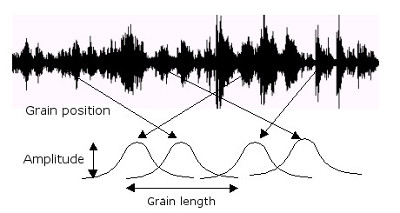join a world beyond music
For this purpose the qualification „beautiful“ or „ugly“ makes no sense for sound, nor for the music that derives from it; the quantity of intelligence carried by the sounds must be the true criterion of the validity of a particular music.
Iannis Xenakis in "Formalized music: Thought and mathematics in composition.", 1963-1992
The crusher-X algorithm is based on the traditional granular synthesis algorithm (Xenakis, Roads, Wilkins), which was invented in the early 1950s. In granular synthesis, short sound fragments (e.g. 50 milliseconds), "the grains," come from a fixed file buffer. The starting time, length and silence between the grains can be modulated. Working with more than one grain at a time is possible, thus you can create complex sound "clouds" from any sound signal.
When experimenting with those (length of grains), I have discovered a certain confusion as to what effect one can expect when setting parameters to certain values. Not only it seemed that length and density each had an impact of its own on the character of the granulated sound, but it also appeared that their relational value was highly important.
Leon Zadorin "Composing with Granular Synthesis"
A "window function" blends in and out the grains at the beginnings and endings of their life cycles. This function determines the character of the continuum and thus the different perceptions. Xenakis recommended the Gaussian window because of its theoretical considerations.

All sound is an integration of grains, of elementary sonic particles, of sonic quanta. Each of these elementary grains has a threefold nature: duration, frequency, and intensity. All sound, even all continuous sonic variation, is conceived as an assemblage of a large number of elementary adequately disposed in time. (...) Hecatombs of pure sounds are necessary for the creation of a complex sound.
Iannis Xenakis in "Formalized music: Thought and mathematics in composition.", 1963-1992
Instead of the “classic” file-based approach, the crusher-X algorithm provides a floating grain buffer which allows real-time input and output. In this floating buffer, the grains are created by several generators routed to several outputs (surround modes) or combined to become single outputs (mono and stereo modes). You are able to apply many unusual modulations to the grains such as pitch, filter, pan, reverse, X-Crush, waveshape as you like - all modulated by independent modulation sources and modulation phases, either synchronized or not synchronized to the host. The X-Crush parameter is unique in the world of granular synthesis: It applies a ring modulation between the overlapping areas of the grains that follow each other. A feedback loop from the output towards the input is capable of generating extremely complex and non-linear sounds.
A complex sound may be imagined as a multi-colored firework in which each point of light appears and instantaneously disappears against a black sky. But in this firework there would be such a quantity of points of light organized in such a way that their rapid and teeming succession would create forms and spirals, slowly unfolding, or conversely, brief explosions setting the whole sky aflame. A line of light would be created by a sufficiently large multitude of points appearing and disappearing instantaneously.
Iannis Xenakis in "Formalized music: Thought and mathematics in composition.", 1963-1992
Now its up to you! Try the free demo and dive in...
 Download crusher-X-DEMO.dmg |
 Download crusher-X-DEMO.zip |
